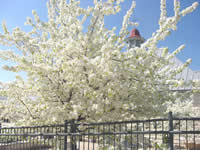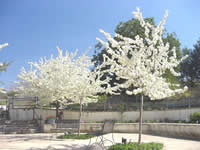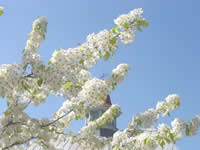Search
For The Answer
Click here to access our database of
Plant Answers
Search
For The Picture
Click here to access the Google database of plants
and insects
Milberger's Nursery and Landscaping
3920 North Loop 1604 E.
San Antonio, TX 78247
210.497.3760
nursery@milbergersa.com

Three exits east of 281, inside of 1604
Next to the Diamond Shamrock station
Please click map for more detailed map and driving directions.



Return
to Gardening Columns Main Index
|
FIREBLIGHT (Alias: "ERWIN") "An ounce of prevention is worth a pound of cure" is an old saying which has much application in the world of growing plants. The idea of prevention rather than cure is especially applicable when diseases caused by fungi and bacteria are considered.
Erwin, known to the scientific world as Erwinia amylovora, is the bacterial organism which causes fire blight of pears, apples and kumquats. Erwin's fire blight becomes painfully apparent to those who have planted pear varieties which are highly susceptible to its ravages. Such varieties include the well-known Bartlett and any of the French-named varieties. These susceptible varieties can be killed in one year by Erwin's blackening destruction. The blackening of leaves, twigs and, in severe cases, limbs resembles fire damage which would be caused if the tree or tree parts affected were burned. Thus the term fire blight. Damaged branches are usually widespread throughout the tree but most apparent in the top, new growth. All varieties are susceptible, but some, such as Kieffer, Monterrey, Orient and Fan-Stil are more tolerant. Fire blight is not much of a problem if temperatures
remain generally below 68 When Erwin gets the warm, moist, well-fertilized environment it likes, a single cell is capable of miraculous feats--it can double itself every hour. That may not sound like much at first, but at the end of a 24-hour period, that one cell has become over 15 million cells. Experiments have shown that a single cell can reproduce enough to infect a tree 2-3 percent of the time. If there are 100 bacterial cells at work in an ideal environment, those 100 are enough to insure practically 100 percent infection. So now, consider the penalties for delaying control measures too long-- each random cell of Erwin suddenly has reproduced its 16 million cells. Thus, the key to successful control measures
is that they must go into effect before the pathogen begins
to multiply rapidly. A preventive attitude must be adopted.
A homeowner may not think he has even a single pathogen overwintering
on his tree and may buttress his confidence because he can't
see any evidence to the contrary. But appearances are deceiving,
and even trained There may be stray bacterial cells of Erwin overwintering in cankers, or they may be on a neighbor's tree. You may ask, if Erwin is on a neighbor's tree, how is he going to get into my yard? Not on the wings of a snow white dove--that's for sure! But what about on the feet of a small brown bee. When bees are actively pollinating blooms, they transmit Erwin from infected trees to previously non-infected trees. Obviously, with the number of industrious bees on the loose and the probability of contamination which exists, pear growers should take measures to curb Erwin's destructive potentials. Antibiotics, such as streptomycin (Agri-Strep), and copper-containing products, such as Kocide 101, will control Erwin if applied at the proper time. For these products to be maximally effective, the first spray should be applied at green tip. (Green tip refers to first bud activity on the tips of branches before bloom occurs.) The objective is to get the level of these products on and in the tissue as high as possible as soon as possible. Apply each product according to label recommendations. Applications should be made in a sequence of 4 or 5 sprays at 7- day intervals, or less if rain occurs, from the time of green tip through petal fall (when the petals fall from the flower). Applications before, during and after bloom are necessary since all pear blooms do not open simultaneously and to insure that when our dirty-footed bee friends visit, Erwin will be killed. It couldn't happen to a more deserving pathogen! These products will not hurt the bee, just sanitize her! Even though bees carry Erwin from tree to tree, take care not to kill them with insect sprays during the bloom period. Honey bees and other insects are necessary to pollinate the bloom. If pollination does not occur, the bloom will fall off and no fruit will develop. Your apple and pear trees will prosper from Erwin-prevention action now and produce an abundance later. But prepare now before you enjoy the first pear blooms of spring. More information can be found at: |



